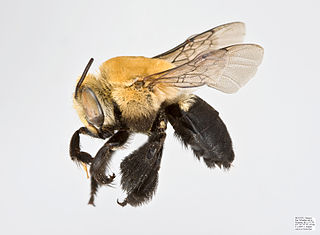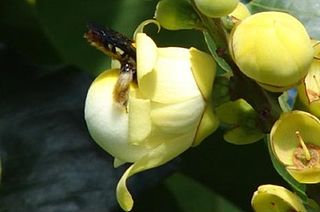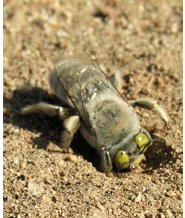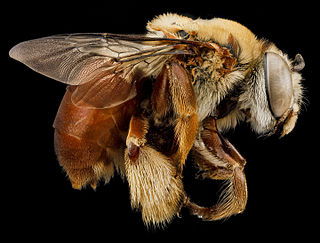
Macintosh Centris is a family of personal computers designed, manufactured and sold by Apple Computer, Inc. in 1992 and 1993. They were introduced as a replacement for the six-year-old Macintosh II family of computers; the name was chosen to indicate that the consumer was selecting a Macintosh in the center of Apple's product line. Centris machines were the first to offer Motorola 68040 CPUs at a price point around US$2,500, making them significantly less expensive than Quadra computers, but also offering higher performance than the Macintosh LC computers of the time.

The genus Centris contains circa 250 species of large apid bees occurring in the Neotropical and Nearctic realms, from Kansas to Argentina. Most females of these bees possess adaptations for carrying floral oils rather than pollen or nectar. They mainly visit plants of the family Malpighiaceae to collect oil, but also visit others such as Plantaginaceae, Calceolariaceae, and Krameriaceae. Recent studies have shown they are sister to the corbiculate bees, the most well-known and economically important group of bees

Parkinsonia, also Cercidium, is a genus of flowering plants in the pea family, Fabaceae. It contains about 12 species that are native to semi-desert regions of Africa and the Americas. The name of the genus honors English apothecary and botanist John Parkinson (1567–1650).

The genus Epicharis contains fewer than 40 species of large apid bees occurring in the Neotropics, most of which possess adaptations for carrying floral oils rather than pollen or nectar. The floral oils are typically gathered from plants of the family Malpighiaceae, though other plants may be visited. They also commonly gather plant resins for use in nest cell construction. Recent studies have shown they are sister to the clade formed by corbiculate bees plus Centris They are large bees, generally with a black head and mesosoma, and the metasoma is often red, and/or has bright yellow spots or bands. They are distinguished from the closely related genus Centris by two sets of three long, whip-like setae that project backwards from just behind the eyes.

Angelonia is a genus of about 30 species which occur from Mexico to Argentina and is classified in the Plantaginaceae. They are herbaceous plants occurring mainly in arid and semi-arid habitats. Most Angelonia species can be found in Northeastern Brazil in the seasonally-dry tropical forest namely Caatinga. The flowers of Angelonia are highly specialized for pollination because they have hairs in the inner corolla, which produces oils collected by oil bee pollinators, especially of the genus Centris.

The Centridini are a tribe of large apid bees, many of which possess adaptations for carrying floral oils rather than pollen or nectar. The floral oils are often gathered from plants of the family Malpighiaceae, though other plants may be visited. The oil-collecting species typically have "combs" composed of closely spaced, flattened, blunt bristles on the margins of the first tarsal segments of the front and middle legs; others may have velvety "pads" to absorb the oils. They also commonly gather plant resins for use in nest cell construction. They have a tiny pterostigma in the forewing, the female scopa is very bushy, and the first flagellomere of the antenna is often longer than the scape.

The Leucospidae are a specialized group of wasps within the superfamily Chalcidoidea, that are ectoparasitoids of aculeate wasps or bees. They are typically mimics of bees or stinging wasps, often black with yellow, red, or white markings, sometimes metallic, with a robust mesosoma and very strong sculpturing. The hind femora are often greatly enlarged, with a row of teeth or serrations along the lower margin as in Chalcididae. The wing has a longitudinal fold. The female ovipositor is sometimes short, but if not, it is recurved and lies along the dorsal side of the metasoma, a unique feature. The males are also unusual, in the fusion of many of the metasomal segments to form a capsule-like "carapace".
John Alcock was an American behavioral ecologist and author. He was the Emeritus' Professor in the School of Life Sciences at Arizona State University.

Krameria erecta is a species of rhatany known by several common names, including Pima rhatany, purple heather, and littleleaf rhatany. It is native to the southwestern United States and northern Mexico, where it grows in dry areas such as desert flats and chaparral slopes. This is a small, tangled shrub under a meter in height with ascending branches covered in silky hairs and fuzzy linear leaves, tips of branches are not thorn-like. The shrub flowers in the spring and again in the fall during wetter years. The showy flower has four or five bright pink cup-shaped sepals and usually five smaller, triangular petals which are pink with green bases. The three upper petals are held erect and the lower two are glandular structures next to the ovary. Next to these are four curving stamens. The species is pollinated by Centris atripes and Centris rhodopus bees. The fruit is a furry heart-shaped body covered in pink spines. It reproduces by seed. This species and others in its genus are root parasites, tapping the tissues of nearby plants for nutrients, especially water. This helps it survive in soil that is almost totally dry.

Centris pallida is a species of solitary bee native to North America. It lacks an accepted common name; however, it has been called the digger bee, the desert bee, and the pallid bee due to its actions, habitat, and color respectively. The solitary nature of this bee allows for a dual-strategy mating system which produces an evolutionarily stable state resistant to invading strategies. These bees have also evolved to withstand the high temperatures of their native habitat. C. pallida routinely has internal temperatures within 3 degrees Celsius of death.
Centris cockerelli is a species in the family Apidae, in the order Hymenoptera . The distribution range of Centris cockerelli includes Central America and North America.

Centris errans, known generally as wandering centris, is a species of centridine bee in the family Apidae. Other common names include the Florida locust-berry oil-collecting bee and spiny bear's-breech. It is found in the Caribbean and North America. The species is one of five from the family Apidae that are endemic to the state of Florida. The species occurs the southernmost portion of Florida.

Centris nitida is a species of centridine bee in the family Apidae. It is found in Central America. It has also been introduced to the US state of Florida.
Centris rhodopus, the red-legged centris, is a species of centridine bee in the family Apidae. It is found in Central America and North America.

Centris lanosa is a species of centridine bee in the family Apidae. It is found in North America.
Centris caesalpiniae is a species of centridine bee in the family Apidae. It is found in Central America and North America.
Centris hoffmanseggiae is a species of centridine bee in the family Apidae. It is found in North America.

Centris analis is a solitary, oil-collecting bee with a geographical range extending from Brazil to Mexico. C. analis is a small, fast-flying bee with an average head width of 3.21mm and 3.54mm for males and females, respectively. While most species of the genus Centris create burrows for nesting, C. analis and other species of the subgenus Heterocentris build nests in pre-existing cavities rather than in the ground. C. analis is a pollinator of many plant species, especially of those in the family Malpighiaceae, which has encouraged its application in acerola orchards.

The genus Chalepogenus, consisting of 21 species of solitary oil-collecting apid bees, demonstrates oligolecty by foraging on oil-producing flowers from the families Calceolariaceae, Iridaceae and Solanaceae. These oil-flowers are abundant in South America, where Chalepogenus is endemic. In contrast to honey bees, Chalepogenus species do not collect nectar; instead, they gather floral oil for various purposes, including provisioning their larvae, constructing nests, and sustaining foraging adult bees. Although oil collection has been reported to be performed by females only, both males and females have specialised oil-collecting structures.











